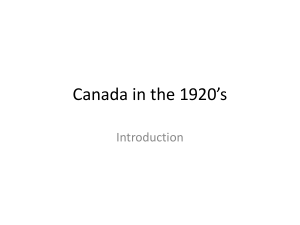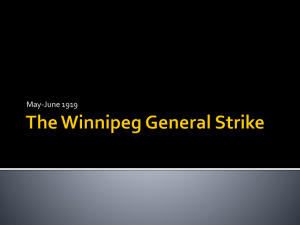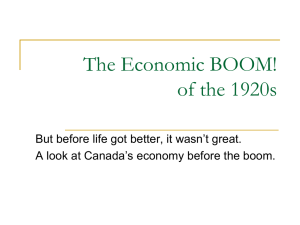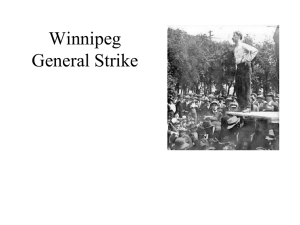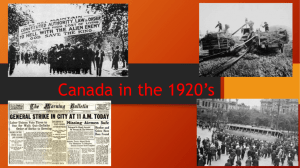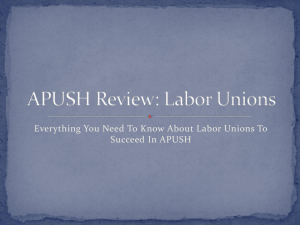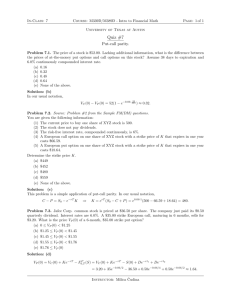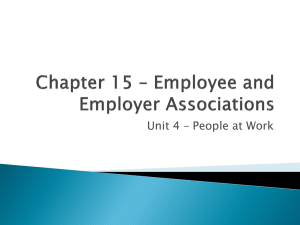Communism and Socialism in Canada
advertisement
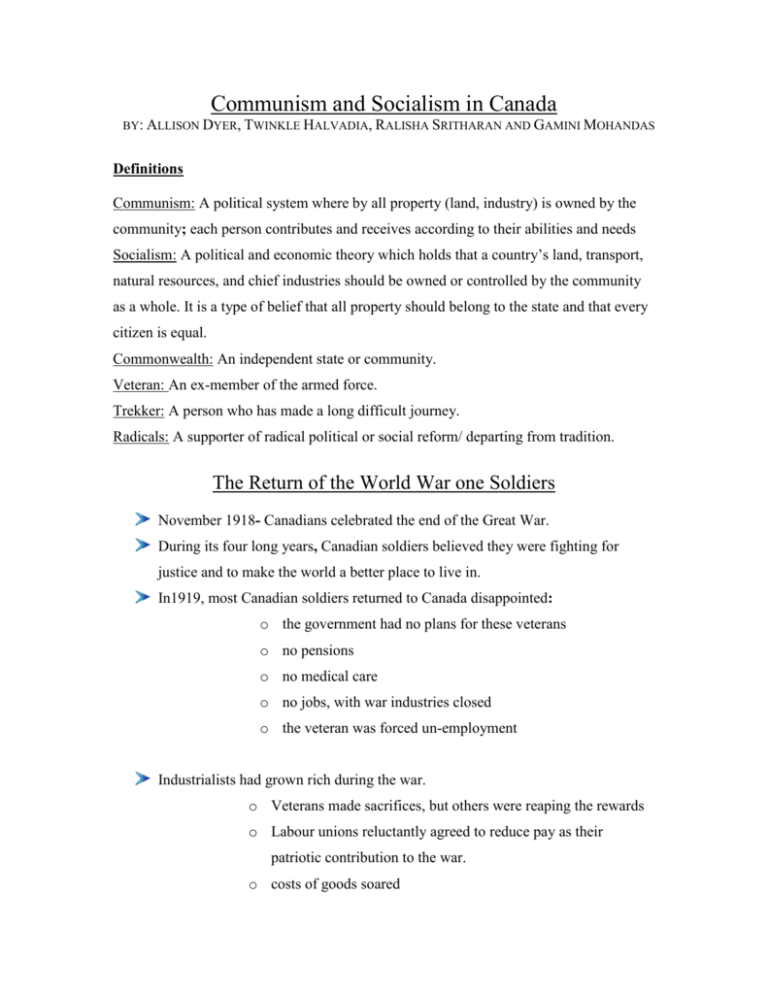
Communism and Socialism in Canada BY: ALLISON DYER, TWINKLE HALVADIA, RALISHA SRITHARAN AND GAMINI MOHANDAS Definitions Communism: A political system where by all property (land, industry) is owned by the community; each person contributes and receives according to their abilities and needs Socialism: A political and economic theory which holds that a country’s land, transport, natural resources, and chief industries should be owned or controlled by the community as a whole. It is a type of belief that all property should belong to the state and that every citizen is equal. Commonwealth: An independent state or community. Veteran: An ex-member of the armed force. Trekker: A person who has made a long difficult journey. Radicals: A supporter of radical political or social reform/ departing from tradition. The Return of the World War one Soldiers November 1918- Canadians celebrated the end of the Great War. During its four long years, Canadian soldiers believed they were fighting for justice and to make the world a better place to live in. In1919, most Canadian soldiers returned to Canada disappointed: o the government had no plans for these veterans o no pensions o no medical care o no jobs, with war industries closed o the veteran was forced un-employment Industrialists had grown rich during the war. o Veterans made sacrifices, but others were reaping the rewards o Labour unions reluctantly agreed to reduce pay as their patriotic contribution to the war. o costs of goods soared o workers suffered 1914 to May 1919- wages had only increased by 18%, but the cost of living had gone up 75% o Wages no longer covered the cost of rent and food for families. Workers looked to the union movement to help them demand a fair share. Labour Movement At the western labour conference in March 1919, the western Canadian union leader proposed founding “One Big Union”. Would represent all the workers of the organization. The goal of OBU is to help workers establish more peaceful means. Their main weapon would be a general strike which is a walkout by all employed workers. A general strike would increase the pressure on the employers to increase their pay and improve the working the working conditions. The labour movement made the politicians and employers nervous Some Canadians were now convinced that foreign “radicals” were infiltrating Canadian unions and plotting the over threw of Canadian society. This fear made the governments and all business very hostile to the unions. All of these tensions came together in Winnipeg on 1919 and for six weeks that spring the city made headlines all over the continent. Co-operative Commonwealth Federation (CCF) As Ottawa struggled to find ways to cope with the depression, the other Canadians suggested solutions. A new political party was formed in the West in1932 The Co-operative Commonwealth Federation (CCF) appealed to a wide variety of Canadians who were unhappy with the current state of affairs These include farmers, labourers, socialists, intellectuals, and disconnected liberals; their leader was J.S Woodsworth The CCF announced its platform I, the Regina Manifesto, drawn up in 1933. Woodsworth began arguing for a national minimum wage and system of social insurance for workers Urged government to spend money on public works in order to create employment The CCF did not win many seats in the 1930’s, but it did provide a clear alternative to the policies of the mainstream parties. The CCF now extends to today’s New Democratic Party (N.D.P) Social Credit Party The social credit party was governed in Alberta, Canada from 1935 to 1971, The social credit party that helped during the depression time period for many people in Alberta. Found on a social credit monetary policy. Founder of party named William Aberhart, known as Bible Bill o A stout and Baptist minister. o One of the 1st preachers in Canada to use the radio to talk about the words of God C.H. Douglas, a Scottish engineer, thought and felt that capitalism was a no use economic system’ said that financial institutions like banks takes money away, which prevents people from buying a lot of food. C.H. Douglas argued with capitalist government that they should give money to increase the spending of money. Aberhart heard about C.H. Douglas’ theory in 1932 o Started to publicize it on the weekly radio program “Voice of the prairie” o Began to combine salvation with economics o Promised the citizen of Alberta either they would get a prosperity certificate of $25 a month or receive a basic dividend. o Wanted everyone living in Alberta to receive $25 a month by the provincial government. o Federal government changed the right of the province to have its own currency. Alberta was under the control of the imperial power of the eastern Canadian government and the international business. Alberta was bankrupt during the depression time period o Alberta was in debt because of this; many people were undergoing poverty o They went to Ottawa to receive provincial rights and ask for an extension to pay off their debt. In the year of 1943 William Aberhart “Bible Bill” died. The social credit party helped eliminated Alberta’s debt. It created the Credit Union Act and the Alberta Treasury Branches to provide low interest loans. The social credit party kept Alberta from free debt and an income free tax province in Canada. The Social Credit Party believes in the rights, freedom, capabilities of the people, democracy, autonomy, local ownership and control. They believed in people working together. The Winnipeg General Strike Early May 1919, Winnipeg’s metal and building trade workers walked off from their jobs. o They were demanding higher wages o a shorter working week o the right to bargain collectively through unions The members of the Winnipeg Trades and the Labour council voted for a general strike in support of these principles. May 15th, 30 000 people left their jobs, although half were not even in any union. Winnipeg was paralyzed o no firefighters o no postal workers o no telephone or telegraph services o no newspapers, street cars, or ice Police wanted to join the walkout but strike leaders convinced them to stay on the job. o There should be no violent confrontations, which would provide an excuse for putting the city under military law. The problem with the General strike strategy was that the workers and their families also needed the break, milk and ice that were not being delivered. o The strike committee began a permit sign. Signs reading “By Authority of the strike committee,” were issued to delivery vans and wagons taking goods to homes and hospitals, and to theatres that opened to keep strikers of the street. The city and provincial governments saw this as a declaration of revolution, a signal that the strike leaders believed themselves to be the authorities in charge of the city. o Business leaders responded by forming the “committee of one thousand”, a group of citizens who took on such tasks as volunteer firefighting and operating gas pumps. The city responded by firing the police, whom they believed to be too sympathetic to the strike. In their place they armed volunteer “specials with clubs and bats. The city’s mayor also appealed to Ottawa for help. o The federal government told striking postal employees they would lose their jobs and pensions unless they went back to work. o Also sent reinforcements for the North-West mounted police and the army in Winnipeg, as well as secret shipments of machine guns. The government was fearful that the strike would spread to other cities. o If Winnipeg’s railway workers went on strike, the nation’s transportation network would be paralyzed. Officials in Ottawa believed that “enemy alien” socialists were behind the strike. Most veterans favored the strikers, but a significant number supported the authorities. o Both sides began to organize mass parades and demonstrations in the city streets. o Striking workers too held large rallies in a downtown park. On June 10, a riot broke out when the club wielding “specials” charged a crowd of people who pelted them with stones, bricks, and bottles. One June 17th, the strike leaders were arrested and whisked away to the penitentiary. All were British or Canadian. To protest the arrests, pro-strike veterans organized a March on June 21st, in a defiance of the mayor’s orders o The resulting clash became to be known as a bloody Saturday. The mounted police charged into the crowd, armed with clubs and pistols. o Two strikers died, thirty were injured and scores were arrested. o Defeated the strikers returned to work on June 26th. What had been achieved? Short run, there is no doubt the union movement was set back. Many workers were not re-hired. Others were taken back only if they signed “yellow contracts”, vowing not to join a union. Divisions between the working class and business grew deeper. o Winnipeg’s reputation suffered and businesses avoided they city. o Long run, the verdict is less clear. A royal commission set up to examine the strike found that the workers grievances were valid. o Gradually much of what they had fought for was achieved. Strike leaders were elected to city council and to provincial and federal Government, Some while still in prison. Their desire to reform would inspire new political parties and there by change the traditional Canadian party system. On-To-Ottawa Trek 1935, thousands of men left the camps in the interior of British Columbia and congregated to Vancouver due to desperation of poor conditions. Their Union, the relief camp workers decided to take their complaints to Ottawa. o The beginning of a protest that came to be known as the OnTo-Ottawa-Trek. “Riding the rails”, crowding into and on top of freight cars, the trekkers rode through the prairies picking up more and more people along the way. When they reached Regina, the RCMP confined them in a local stadium, allowing only the leaders to proceed to Ottawa. The leaders met with the Prime Minster Bennett with great hope, but Bennett made his position clear immediately he attacked the leaders as radicals and trouble makers. He cleared one leader, Slim Evans a “criminal and a thief”, Evans responded, “And you’re a liar, Bennett and what is more you are not fit to run a great country like Canada.” The delegation was hustled out of the PM’s office at once. The order was given to clear all trekkers out of the Regina stadium. o The trekkers battled the RCMP for two hours. One man was killed, many were injured, and 130 trekkers were arrested. The government was convinced that the Trekkers were agitators and communists. o So great the fear of Social that communism had been outlawed in 1931. In a shocked response to the Trek and the Regina riot, the right for speaking their minds on the situation and foreigners so often as radicals were threatened with deportation. ONE BIG UNION March, 1919 at the Western Labour Conference, union leaders proposed founding One Big Union (O.B.U) → would represent all workers in one organization. → the goal was to help workers establish more control of industry and a Government through peaceful means. → the main weapon would be a general strike, a walkout by all Employed workers. Western Canada union leaders became openly socialist in their policies. o Borrowed ideas from the trade union movement in Britain: This aimed to form a government that cared more about the working class. o Some influenced about events in Russia, where a revolution had begun in 1917: workers had deposed their royal head of state, the czar, in the name of communism, the belief that all the means of production and distributions (such as farms, factories, railways, and stores) should be publicly owned. A general strike would increase pressure on employers to raise pay and improve working conditions. It could also be used to bring down the existing orders that is, to transfer power from Industrialists and politicians to the workers and their unions. The labour movement made politicians and employers nervous. The Russian Revolution had shaken them to the care. o The workers party had seized control, killing the Czar and his family. Some Canadians were now convinced that foreign “radicals” (political extremists) were infiltrating Canadian Unions and plotting the overthrow of Canadian society. This fear made the Government and businesses very hostile to the Unions. All of these tensions came together in Winnipeg in 1919. RED SCARE Communist agents were planning to overthrow the American government The “first red scare” began during WWI Tensions were further elevated during this time owing to a widespread campaign of violence by various groups inspired by the Bolshevik revolution in Russia. Focus Questions 1.) The federal government told the striking postal unions they would lose their jobs and pensions unless they went back to work. WWI soldiers were never offered pension when they returned. Is this fair? Do you think this is because veterans were of no use once the war was over, and postal services were still needed? 2.) What reasons would officials in Ottawa have to believe that “enemy aliens” socialists were behind the Winnipeg general strike? 3.) If the Social Credit party was not created what would happen to Alberta? 4.) Do you think the cause for a labour movement could be avoided or handle better now in present years? Consequences The result of communism and socialism has led to a more democratic Canada; the labour movement helped the working class exercise their rights. The government took more responsibility over the citizens of Canada. The political system is still influenced by the “roaring 20’s” where new underground political parties were formed to address all the nationalities and classes of Canadians. References: History Textbook Grade 10 academic http://archives.cbc.ca http://www.civilization.ca/hist/labour/lab01e.html http://www.ontoottawa.ca/index1.html http://history.cbc.ca/history/?MIval=EpisContent.html&series_id=1&episode_id=13&cha pter_id=3&page_id=4&lang=E http://history.cbc.ca/history/?MIval=EpisContent&series_id=1&episode_id=13&chapter_ id=3&page_id=2&lang=E http://www.socialcredit.com/history.htm

